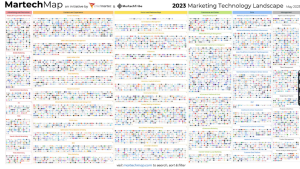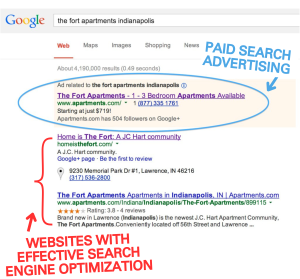Butch M. Sarma, M.B.A.

-Butch M. K. Sarma, Chapter 13 Author

INTRODUCTION
Digital marketing is a fast-growing technology-driven collection of platforms, tools, skills, and content allowing companies to engage with previous, current, and prospective customers. Note the buyer behavior funnel (awareness, interest, consideration, intent, evaluation, and purchase) is still there, but the friction between stages is greatly reduced and the time interval may be almost instantaneous.
THE IMPORTANCE OF DIGITAL TECHNOLOGIES FOR MARKETING
In today’s fast-paced and ever-evolving business landscape, digital technologies have become indispensable tools for marketers. As future business leaders and marketers, it is crucial to understand how these technologies can enhance your marketing strategies, drive customer engagement, and ultimately contribute to business success.
Digital technologies have revolutionized the way businesses interact with their customers. Social media platforms, websites, email marketing, and mobile apps have transformed the traditional marketing funnel, making it more dynamic and interactive. These tools enable marketers to reach a broader audience, personalize marketing messages, and engage with customers in real-time. Understanding the power of digital marketing is essential for crafting effective campaigns that resonate with your target audience.
Moreover, digital technologies provide valuable insights through data analytics. Marketers can now track customer behavior, preferences, and trends with unprecedented accuracy. This data-driven approach allows for more informed decision-making, optimizing marketing efforts and improving return on investment (ROI). For instance, by analyzing website traffic and social media interactions, you can identify which marketing channels are most effective and adjust your strategy accordingly. Imagine a new guitar company called “Hank’s Hollow Bodies” that wants to figure out how best to reach their target audience of 40-55 year-old men.
 They have a presence on multiple different social media platforms, but they don’t know which is most effective in reaching their audience. After analyzing social media interactions, they found that on Facebook, the same ad got 3x more likes and 5x more views than it did on the other platforms. The company now plans to post more times per week on Facebook.
They have a presence on multiple different social media platforms, but they don’t know which is most effective in reaching their audience. After analyzing social media interactions, they found that on Facebook, the same ad got 3x more likes and 5x more views than it did on the other platforms. The company now plans to post more times per week on Facebook.
BASICS OF MARKETING TECHNOLOGIES (MARTECH)
Marketing Technologies, or MarTech, refer to the various tools and platforms used by marketers to plan, execute, and analyze their campaigns online. Familiarizing yourself with MarTech is crucial for navigating the digital marketing landscape effectively and enhancing a company’s marketing capabilities (Brinker). With that said, the goal of this chapter is for you to become familiar with broad categories of tools—but when we zoom into the specific, Scott Brinker, the creator of the MarTech 5000 landscape, lists over 11,000 MarTech tools available!

MarTech encompasses a wide range of tools, including customer relationship management (CRM) systems, email marketing platforms, social media management tools, and analytics software. CRM systems, like Salesforce and HubSpot, help businesses manage and analyze customer interactions, improving customer retention and satisfaction. Email marketing platforms, such as Mailchimp and ConstantContact, enable targeted and automated email campaigns, enhancing customer engagement.
Social media management tools, like Hootsuite and Sprout Social, allow marketers to schedule and monitor posts across multiple platforms, ensuring a consistent and strategic online presence. Analytics software, such as Google Analytics and Adobe Analytics, provides insights into website performance and user behavior, helping to refine marketing strategies.


In summary, understanding and leveraging digital technologies and MarTech tools are critical skills for modern marketers. These technologies not only enhance marketing efforts but also provide the insights needed to make data-driven decisions, ultimately driving business success. As you progress in your marketing studies, mastering these tools will be key to your future career in the dynamic field of marketing.
DEVELOPING AN ONLINE AUDIENCE AND UNDERSTANDING WEBSITE TRAFFIC SOURCES
In the digital age, developing an online audience is crucial for marketers. Engaging with customers online not only increases brand visibility, it also drives conversions and fosters customer loyalty. So as you begin your journey to become a marketer, understanding the importance of online audiences and the methods of building theme, as well as differentiating sources of website traffic and leads, is essential for you to develop effective marketing strategies.
Importance and Methods for Developing an Online Audience
Developing an online audience allows businesses to enhance their ability to communicate directly with potential and existing customers. For some firms, such as smaller or new companies, the goal might be to reach a wider audience. For example, think of a new bakery called “I Knead Bread.” They just opened up their first location and want to get the word out, so they start posting short videos on Instagram and Facebook. For larger, more established companies, the goal might instead be to reach a more targeted audience. Imagine that the running shoe company Brooks decides they want to reach teenage runners in hopes of fostering brand loyalty and a lifetime of repurchase behaviors. In order to achieve this goal, they partner with running influencers to create content on Brook’s TikTok page.
A strong online presence also provides valuable data and insights into customer behavior, preferences, and trends, enabling more personalized and effective marketing efforts. However, the extent to which this can be achieved depends on the degree of control over the audience the company has. Building an audience on a third-party platform (e.g., Instagram, TikTok, Facebook, etc.) leaves ultimate control to the platform owner, who may implement algorithmic changes without your company’s consent and even remove you from their platforms without the possibility of you appealing the decision. Hence, building an audience that directly comes to your website or other digital touchpoints is the ideal, as it gives your company full control.
Several methods can help marketers build and engage an online audience:
- Content Marketing: Creating valuable, relevant, and consistent content helps attract and retain a clearly defined audience. Blogs, videos, infographics, and social media posts are effective tools for engaging audiences and establishing authority in a particular niche (Pulizzi, 2014).
- Search Engine Optimization (SEO): Optimizing website content for search engines increases visibility and drives organic traffic. Effective SEO involves using relevant keywords, creating high-quality content, and building backlinks from reputable sites (Fishkin & Høgenhaven, 2013). Implementing the updates from Google can improve the results of your website.
- Social Media Marketing: Leveraging social media platforms allows marketers to interact with audiences in real-time, build communities, and promote content. Consistent posting and engaging with followers through comments and messages can significantly boost audience engagement (Tuten & Solomon, 2017). Note the control issues mentioned previously.
- Email Marketing: Building an email list and sending regular newsletters can nurture relationships with customers. Personalized and targeted email campaigns can drive traffic to the website and convert leads into customers (Chaffey & Ellis-Chadwick, 2019). Email is the number one form of content because the user opts in to receive it: as such, this essentially means that the consumer has given permission for your company to engage with them, a concept popularized in Seth Godin’s “Permission Marketing” book. The permission-based avenue of email can be accessed amongst the user’s devices and is easy for all users to understand.
Beyond simply contacting consumers, rigorous testing of email content, such as subject lines, can deliver improvements over time—for example, whether an email title includes a call to action. Given the value of email marketing to companies, email lists are considered assets to the organization and can impact a firm’s balance sheet during an acquisition or sale. Finally, note that there are specific laws in the US for email and it is important for marketers engaged in email marketing to be familiar with these laws.
Differentiating Sources of Website Traffic and Leads
Developing an audience encompasses not only various methods to reach an audience, but also various ways in which the audience can search and reach your company. As such, understanding where website traffic and leads come from is vital for optimizing marketing strategies. The primary sources of website traffic include:
- Organic Traffic: Visitors who find the website through search engines. High-quality content and effective SEO strategies can increase organic traffic (Fishkin & Høgenhaven, 2013).
- Direct Traffic: Visitors who type the website URL directly into their browser. This often indicates brand awareness and loyalty (Chaffey & Ellis-Chadwick, 2019).
- Referral Traffic: Visitors who come from other websites through backlinks. Building relationships with reputable websites and engaging in guest blogging can boost referral traffic (Pulizzi, 2014).
- Social Traffic: Visitors from social media platforms. Consistent and engaging social media presence drives social traffic (Tuten & Solomon, 2017).
- Paid Traffic: Visitors who arrive through paid advertisements, such as Google Ads, display ads, or social media ads. Paid traffic can provide quick results and targeted reach (Chaffey & Ellis-Chadwick, 2019).
In conclusion, developing an online audience and understanding the sources of website traffic are critical skills for modern marketers. By leveraging content marketing, SEO, social media, and email marketing, and by analyzing traffic sources, marketers can optimize their strategies and drive business success.
KEY CONCEPTS AND METHODS IN SEARCH MARKETING
All of the multiple audience development methods and traffic sources would be ineffective if consumers are not actively searching for our company! Search marketing is a crucial component of digital marketing that involves promoting websites by increasing their visibility in search engine results pages (SERPs) through paid and unpaid strategies. Accordingly, the primary methods in search marketing include search engine optimization (SEO) and paid search advertising, commonly referred to as pay-per-click (PPC) advertising.
Search engine optimization (SEO) involves optimizing website content and structure to rank higher in organic (non-paid) search engine results. Key SEO practices include keyword research, on-page optimization, and off-page optimization. Keyword research entails identifying the terms and phrases potential customers use to search for products or services. On-page optimization focuses on improving elements within the website, such as meta tags, headings, and content quality. Off-page optimization involves activities outside the website, like building high-quality backlinks from other reputable sites (Fishkin & Høgenhaven, 2013). The goal is to be on the first page of the major search engines’ results page (SERP).
SEO does not exist in a vacuum, and is most effective alongside high-quality content. Effective SEO ensures that a website is easily discoverable by search engines, making it more accessible to potential customers. High-quality content, in turn, engages users, answers their queries, and encourages them to spend more time on the site. Search engines favor websites that provide valuable and relevant content, which improves rankings and attracts more organic traffic (Pulizzi, 2014).
Paid search advertising (PPC) involves paying for advertisements that appear at the top of search engine results for specific keywords. Advertisers bid on keywords, and when users search for those terms, their ads appear alongside organic results. PPC ads are a way to quickly gain visibility and attract targeted traffic to a website (Chaffey & Ellis-Chadwick, 2019). The main providers are Google and Bing.

Interaction Between Paid Ads and Organic Search Results
Paid ads and organic search results interact in several ways. Combining both strategies can enhance overall visibility and credibility. While SEO builds a strong foundation for long-term success, PPC ads provide immediate visibility. When a website appears in both paid ads and organic results, it can dominate the SERPs, increasing the likelihood of user clicks and reinforcing brand authority (Tuten & Solomon, 2017).
Furthermore, data from PPC campaigns can inform SEO strategies. Insights gained from ad performance, such as high-performing keywords and user behavior, can help refine SEO efforts. Conversely, a well-optimized website with strong organic rankings can reduce the cost-per-click (CPC) in PPC campaigns, as search engines often reward high-quality, relevant websites with lower ad costs (Chaffey & Ellis-Chadwick, 2019). Also, PPC campaigns can be run to test new product ideas and test marketing areas for possible new retail locations.
In conclusion, mastering the key concepts and methods in search marketing, understanding the importance of SEO and content, and leveraging the interaction between paid ads and organic search results are essential skills for modern marketers. These strategies work together to enhance visibility, drive traffic, and ultimately achieve marketing goals.
KEY CONCEPTS AND METHODS IN DIGITAL AD TARGETING
So far, we have discussed how companies can use various methods to build an audience, and ensure that their website or other touchpoint is immediately available as consumers search for information. But there are more tools at our disposal! In fact, we will next discuss a classic tool in marketers’ arsenal: advertising. Digital ad targeting is a critical aspect of modern marketing, enabling marketers to deliver personalized ads to specific segments of their audience. The main goal is to reach the right people with the right message at the right time, thereby increasing the efficiency and effectiveness of advertising campaigns. Here are the key concepts to know in digital ad targeting:
- Audience Segmentation: This involves dividing the broader audience into smaller, more manageable groups based on specific criteria such as demographics, psychographics, behavior, and geographic location. Effective segmentation ensures that ads are relevant to the needs and preferences of different audience segments (Chaffey & Ellis-Chadwick, 2019).
- Behavioral Targeting: This method uses data on users’ past behaviors, such as website visits, searches, and purchases, to serve relevant ads. By analyzing patterns in user behavior, marketers can predict future actions and tailor ads accordingly (Tuten & Solomon, 2017).
- Contextual Targeting: This approach involves placing ads on web pages that are contextually relevant to the ad content. For example, an ad for running shoes might appear on a fitness blog. This increases the likelihood that the ad will resonate with the audience (Chaffey & Ellis-Chadwick, 2019).
- Retargeting: Also known as remarketing, this strategy targets users who have previously interacted with a brand but did not convert. By showing them ads on other websites or social media platforms, marketers can remind them of the brand and encourage them to complete the desired action (Fishkin & Høgenhaven, 2013). This is also known as remarketing or “follow me” ads.
Interaction Between Segmentation and Ad Targeting
Segmentation and ad targeting are deeply interconnected processes that together enhance the precision and effectiveness of digital advertising. Segmentation provides the foundation for targeting by identifying distinct groups within the broader audience. This allows marketers to craft specific messages that address the unique needs and preferences of each segment.
Ad targeting then takes these segments and delivers personalized ads to them. For instance, a clothing brand may segment its audience into groups based on age, gender, and fashion preferences. The brand can then create different ads for each segment, such as promoting trendy outfits to younger audiences and classic styles to older segments. This targeted approach increases the relevance of the ads, leading to higher engagement rates and improved ROI (Chaffey & Ellis-Chadwick, 2019).
Moreover, segmentation allows for more effective use of marketing budgets. By focusing resources on the most valuable segments, marketers can avoid wastage and ensure that their ads are seen by those most likely to convert. The feedback from these targeted ads also provides valuable insights into segment behaviors and preferences, which can further refine segmentation strategies and improve future campaigns (Tuten & Solomon, 2017).
In summary, mastering digital ad targeting and understanding its interaction with segmentation are crucial for creating effective, efficient, and personalized marketing campaigns. These techniques enable marketers to connect with their audience on a deeper level, driving engagement and conversions.
THE BUSINESS BEHIND AD PLACEMENTS
Display ads can be placed by your ad agency through the platform directly (Meta Ads Manager), and directly with website owners like a local newspaper. Display ads can be static (not moving), dynamic (e.g., ads that expand when you hover over them with your mouse cursor), or video. Display ads have standard sizes and are regulated by the Internet Advertising Bureau, an industry trade group. No matter what type of ad, the creative quality matters the most. The click-through rate (CTR) is the percentage of individuals viewing a web page who view and then click on a specific advertisement that appears on that page The 2020 average CTR on Instagram feed ads was 0.22%. With the low click rate by users, display ads need to be high quality and purchased in large quantities. Display ads are sold in lots of 1,000 or as a sponsorship. Sponsorships are a way to buy all of the website traffic for a specific period, like an hour or a day for everyone on the sports page of the newspaper website. Everyone will see your ad during that period. Display ads are placed by an Ad Ops team using an Ad Server, which allocates all of the ads to the website based on the forecast number of users that day.
For example, the local Ford dealer wants to buy 1 million display ad impressions for the month on the local newspaper website. The newspaper will set the price for the impressions in 1000 ad units and then forecast available inventory for the upcoming month’s website traffic based on linear regression models. The newspaper’s Ad Ops team will load the ad’s creative image (a gif file), the click-through URL, and the quantity purchased for the month in the ad server. On day one of the month, the ad server will publish the Ford dealer’s ad about 32,250 times (1 million impressions divided by 31 days equals 32,250 impressions per day), spread evenly across 24 hours. If the newspaper user traffic is high the ad server will adjust the quantity to show fewer ads per hour and more ads per hour if the website traffic is light. At the end of the month, the newspaper will give the Ford dealer a report showing the total number of ads shown and the number of clicks by users. There may be a slight variance in the quantity of ads delivered up to +/- 5%.

THE IMPORTANCE OF DIGITAL MARKETING METRICS FOR DECISION-MAKING
Digital marketing metrics are vital tools for marketers, providing the data needed to make informed decisions and optimize marketing strategies. Understanding and utilizing these metrics allows marketers to measure the effectiveness of their campaigns, identify areas for improvement, and align marketing efforts with business goals.
Importance of Digital Marketing Metrics
Digital marketing metrics offer insights into various aspects of a marketing campaign, from audience engagement to conversion rates. These marketing metrics help marketers track progress, evaluate performance, and adjust strategies in real-time. By analyzing key performance indicators (KPIs) such as website traffic, click-through rates (CTR), and return on investment (ROI), marketers can determine which tactics are working and which need refinement (Chaffey & Ellis-Chadwick, 2019).
Move the slider to the left to test your knowledge of these acronyms.
Moreover, digital marketing metrics enable marketers to justify marketing expenditures and demonstrate the value of marketing activities to stakeholders. Metrics provide tangible evidence of the impact of marketing efforts on business outcomes, facilitating data-driven decision-making and strategic planning.
Connecting Web Metrics Analytics to Business Goals
Web metrics and analytics play a crucial role in connecting digital marketing activities to broader business goals. Metrics such as traffic sources, bounce rates, and conversion rates offer a detailed view of how users interact with a website, providing insights into user behavior and preferences (Fishkin & Høgenhaven, 2013).
- Traffic Sources: Understanding where website traffic originates (organic search, direct, referral, paid, or social media) helps marketers identify which channels are most effective in driving visitors to the site. This information can guide budget allocation and strategy development to focus on high-performing channels (Chaffey & Ellis-Chadwick, 2019).
- Bounce Rate: The bounce rate measures the percentage of visitors who leave the website after viewing only one page. A high bounce rate may indicate issues with website design, content relevance, or user experience. Reducing the bounce rate by improving these factors can enhance user engagement and increase the likelihood of conversions (Pulizzi, 2014).
- Conversion Rate: The conversion rate tracks the percentage of visitors who complete a desired action, such as making a purchase or signing up for a newsletter. Monitoring conversion rates helps marketers assess the effectiveness of their calls to action and overall marketing strategy. Optimizing for higher conversion rates aligns marketing efforts with business goals, such as revenue growth and customer acquisition (Tuten & Solomon, 2017). A small improvement in the conversion rate (assuming acquisition levels are the same), will deliver a big improvement in results for the organization. Don’t just buy more ads, focus on getting the % of people converting on your website to increase.
By regularly analyzing these and other metrics, marketers can ensure their strategies are effectively driving business goals. Metrics provide a clear link between marketing activities and outcomes, enabling continuous improvement and alignment with organizational objectives.
SUMMARY
To recap, this chapter covered the importance of MarTech and digital technologies for modern marketers. It also explored why cultivating an online audience and also understanding the sources of website traffic are critical skills. Further, you read about key concepts and methods in search marketing, SEO and content, the interaction between paid ads and organic search results, and why these are valuable topics to familiarize yourself with. It explained how digital ad targeting and its interaction with segmentation are crucial for creating effective marketing campaigns. Last, you read about how digital marketing metrics help marketers to optimize their strategies as well as showcase the value of marketing activities to stakeholders.
REFERENCES
Chaffey, D., & Ellis-Chadwick, F. Digital Marketing: Strategy, Implementation and Practice (7th ed.). Pearson. 2019.
Scott, D. M. The New Rules of Marketing and PR: How to Use Social Media, Online Video, Mobile Applications, Blogs, News Releases, and Viral Marketing to Reach Buyers Directly (6th ed.). Wiley. 2017.
Brinker, S. (n.d.). Chief Marketing Technologist Blog. Retrieved from Chiefmartec.
Google Analytics. (n.d.). Analytics Academy. Retrieved from Google Analytics Academy.
Fishkin, R., & Høgenhaven, T. Inbound Marketing and SEO: Insights from the Moz Blog. Wiley. 2013.
Pulizzi, J. Epic Content Marketing: How to Tell a Different Story, Break through the Clutter, and Win More Customers by Marketing Less. McGraw-Hill. 2014.
Tuten, T. L., & Solomon, M. R. Social Media Marketing (3rd ed.). SAGE Publications. 2017.
US Federal Trade Commission, CAN-SPAM Act: A Compliance Guide for Business, https://www.ftc.gov/business-guidance/resources/can-spam-act-compliance-guide-business
The Interactive Advertising Bureau (IAB), https://www.iab.com/
Smart Insights, 2024 average ad click through rates (CTRs) for paid search, display, and social media by Dave Chaffey,. https://www.smartinsights.com/internet-advertising/internet-advertising-analytics/display-advertising-clickthrough-rates/. January 2024.
Kaushik, A., Occam’s Razor blog. https://www.kaushik.net/avinash/
Media Attributions
- 13
- Facebook by BookGlutton licensed under CC BY 2.0. Guitar by Dmitry Ganin, licensed under Unsplash license.
- Martech Map Copyright Scott Brinker
- Instagram by StockCatalog, licensed under CC BY 2.0
- Analyst by David Stewart, licensed under CC BY 2.0
- ILSs advertising on Google by 30lines, licensed under CC BY-SA 2.0
- Woman by Marcus Aurelius via Pexels, licensed under CC BY 2.0. Calculator by Kaboompics.com via pexels, licensed under CC BY 2.0. Ford Torino Ad licensed under CC Public Domain. Pen by Lukas via Pexels, licensed under CC BY 2.0
The various tools and platforms used by marketers to plan, execute, and analyze their campaigns online
Help businesses manage and analyze customer interactions, improving customer retention and satisfaction
Enable targeted and automated email campaigns, enhancing customer engagement
Allow marketers to schedule and monitor posts across multiple platforms, ensuring a consistent and strategic online presence
Provides insights into website performance and user behavior, helping to refine marketing strategies
Creating valuable, relevant, and consistent content helps attract and retain a clearly defined audience
Involves optimizing website content and structure to rank higher in organic (non-paid) search engine results
Leveraging social media platforms allows marketers to interact with audiences in real-time, build communities, and promote content
Building an email list and sending regular newsletters can nurture relationships with customers
Visitors who find the website through search engines
Visitors who type the website URL directly into their browser
Visitors who come from other websites through backlinks
Visitors from social media platforms
Visitors who arrive through paid advertisements, such as Google Ads, display ads, or social media ads
Entails identifying the terms and phrases potential customers use to search for products or services
Focuses on improving elements within the website, such as meta tags, headings, and content quality
Involves activities outside the website, like building high-quality backlinks from other reputable sites
Involves paying for advertisements that appear at the top of search engine results for specific keywords
Enables marketers to deliver personalized ads to specific segments of their audience
Involves dividing the broader audience into smaller, more manageable groups based on specific criteria such as demographics, psychographics, behavior, and geographic location
A method that uses data on users' past behaviors, such as website visits, searches, and purchases, to serve relevant ads
An approach that involves placing ads on web pages that are contextually relevant to the ad content
Also known as remarketing, this strategy targets users who have previously interacted with a brand but did not convert
The percentage of individuals viewing a web page who view and then click on a specific advertisement that appears on that page
Offer insights into various aspects of a marketing campaign, from audience engagement to conversion rates
Understanding where website traffic originates (organic search, direct, referral, paid, or social media) helps marketers identify which channels are most effective in driving visitors to the site
Measures the percentage of visitors who leave the website after viewing only one page
The conversion rate tracks the percentage of visitors who complete a desired action, such as making a purchase or signing up for a newsletter
